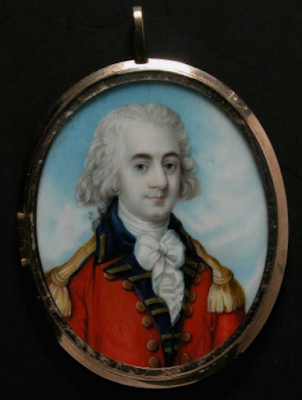Well, hurrah for Friday! I know we're only 2 days in, but I'm knackered this week, mainly because I have a cold. Today's Stabvent offering is one from the exhibition I have been involved with down at the Russell-Cotes in Bournemouth...
 |
| The King's Drum Shall Never be Beaten for Rebels, 1798 (1892) George William Joy |
Here we have a little drummer boy of the Antrim Regiment by the name of Hunter, aged 12, who has been captured by Irish Rebels during the Uprising of 1798, after the appropriately named Battle of Gorey. The boy was captured, taken into the town of Gorey and told he was the drummer for the Rebels now, but little Hunter kicked in his drum, declaring that 'the King's Drum shall never be beaten for Rebels!' The Rebels didn't take it very well, apparently...
 |
| The King's Drum Shall Never be Beaten for Rebels (1845) George Cruikshank |
You can see the Rebels in Joy's picture looking less than impressed and a good skewering is definitely on the cards for little Hunter. The pikeman to his left advances with murderous intent, while the officers, including one of the French soldiers who were fighting on the side of the Irish, look on. Now, call me cynical but it does rather have the smell of propaganda about it. Look at heroic little Hunter about to be piked to death by a bunch of Catholics! Outrageous! It was generally believed that Joy's painting of it, coinciding with the growth in Irish Home Rule campaigning, was there to show us all how little the Irish (and the French, obviously) can be trusted. However, the tale of Little Hunter is quite well recorded, appearing in William Hamilton Maxwell's History of the Irish Rebellion in 1798, and his death is connected to that of Colonel Lambert Walpole, who also died around Gorey.
 |
| Colonel Lambert Theodore Walpole (c.1790) British School |
The story appears in memoirs, including an 1824 Soldier's Companion, but it is one of a grand tradition of stealing matyrdom from the jaws of defeat that the Victorians excelled in (as we will see). I'm not saying little Hunter didn't exist - quite the contrary, I'm sure lots of Little Hunters marched into Battle and died in horrible ways. Children soldiers still exist all over the world and I wonder if their needless sacrifice is still used as propaganda. I have so many questions - what is worse, the enemy that kills them or the allies that insist it is a good idea to involve children in war in the first place? I am reminded of a painting I saw in Paris, and if anyone can email me and tell me what it was I will be extremely grateful as it's driving me mad - there is a boy soldier getting massively skewered possibly in a Napoleonic type setting. It's all very heroic and revolting. Any ideas pop them over to me at stonellwalker@googlemail.com and I'll include it in Stabvent with grateful thanks.
.jpg) |
| An English Drummer Boy (1902) George W Joy |
George William Joy (1844-1925) was Irish of French descent, but very definitely Protestant (descended from Huguenots who settled in 17th century Antrim). He was unsurprisingly against Home Rule, decidedly for the Union and painted a number of patriotic images that reflected this, including the very romantic The First Union Jack...
 |
| Lavinia was hoping he wouldn't notice she had sewn the flag to her skirt... |
We will definitely have another meeting with Mr Joy later in Stabvent but I think the moral of today's picture is that however appalling12 year old boys are, they don't deserved to get piked by the French. For all of you with pre-teen sons this Christmas, that is probably a good thing to remember...
See you tomorrow.



.jpg)

Thanks, Kirsty. I laughed at your line description of The First Union Jack. That would make a great card!
ReplyDeleteBest wishes
Ellie